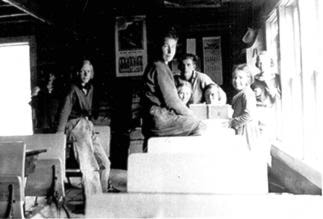Settlers took up residence along the west end of Francois Lake long before there were roads to the area. Although Indigenous people used the land for centuries, the first Caucasians to live there after Edward Pomeroy Colley and his party surveyed it in 1905 were trappers.
It wasn’t long, though, before farmers followed. Lee Newgaard settled on the north side of Francois Lake near its west end in 1915, walking nearly 80 kilometers to Houston twice a year for supplies. In 1923, he ended his bachelorhood by marrying Nora Middleton. When the couple opened a store and post office over a decade later, the community served by the establishment derived its name from theirs.
By the 1930s, there were enough families in Noralee to warrant construction of a school. The log structure had both students and a teacher when it opened in September 1937, but no desks; Martin O’Connell, who later became a professor at the University of Toronto and a Liberal cabinet member in Pierre Trudeau’s government, conducted his first classes outside.
The original log school remained in use for more than decade before residents started petitioning for a new facility.
“The log building became infested with bats, from which came strange looking insects,” Doris Carleton, who taught at Noralee for seven years, recalls. “We consulted Mr. (Fred) Tolhurst, who was quite knowledgeable on a lot of subjects, but even he was mystified. To solve the mystery, he sent a sample to Victoria to be analyzed. The report came back informing us that (the insects) were quite harmless, however they didn’t make the children and I feel comfortable. Besides, the bats continued to entertain us by squeaking and scratching in the insulation, sawdust, in the gable ends of the school.”
The community got a new, larger school in 1952. The original building was burned to prevent it from being a hazard to livestock.
Declining enrollment eventually forced School District 55 to close the Noralee School. It was sold by sealed tender in 1965.
© 2018 Michael Riis-Christianson and the Lakes District Museum Society
